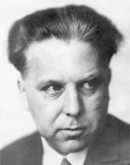

Emil Fahrenkamp
*8. 11. 1885 – Aachen, Germany
†24. 5. 1966 – Ratingen, Germany
Biography
Emil Fahrenkamp was a German interwar architect and university teacher who led the Art Academy in Düsseldorf from 1937 to 1946. Among his most notable works is the headquarters of the Dutch oil company Shell in Berlin. After gaining experience with Carl Sieben and Albert Schneider in Aachen, he moved to Düsseldorf, where he worked in the office of Wilhelm Kreis from 1909 to 1912 and from 1911 served at the Düsseldorf School of Applied Arts, initially as an assistant and later as an auxiliary teacher. In 1919, the school was transformed into an art academy, and Fahrenkamp became a professor. In the 1920s, he was one of the most significant architects in Germany. While maintaining traditional concepts, he was able to adopt contemporary trends (expressionist architecture, modernist movement Neues Bauen) and integrate them into his works in a balanced way. Fahrenkamp maintained good relations with industrialists in the Rhineland and Westphalia, which significantly contributed to his professional success.
After the failure of the National Socialist director Peter Grund, Fahrenkamp took over (originally on a temporary basis) the leadership of the Art Academy in Düsseldorf in 1937, where he directed the teaching closer to practical needs and collaboration with industry. He considered himself and his work apolitical, but he could hold a leading position most likely due to good contacts with high representatives of the Nazi regime (H. Göring, J. Goebbels). Among other things, he built studios for Hermann Göring's painting master school. After World War II, due to his high position in the Third Reich, he was cut off from further cultural life. While other artists resisted such treatment and even swept their past under the rug, Fahrenkamp completely withdrew from public life, but remained an active architect until the end of his life.
Emil Fahrenkamp was a German interwar architect and university teacher who led the Art Academy in Düsseldorf from 1937 to 1946. Among his most notable works is the headquarters of the Dutch oil company Shell in Berlin. After gaining experience with Carl Sieben and Albert Schneider in Aachen, he moved to Düsseldorf, where he worked in the office of Wilhelm Kreis from 1909 to 1912 and from 1911 served at the Düsseldorf School of Applied Arts, initially as an assistant and later as an auxiliary teacher. In 1919, the school was transformed into an art academy, and Fahrenkamp became a professor. In the 1920s, he was one of the most significant architects in Germany. While maintaining traditional concepts, he was able to adopt contemporary trends (expressionist architecture, modernist movement Neues Bauen) and integrate them into his works in a balanced way. Fahrenkamp maintained good relations with industrialists in the Rhineland and Westphalia, which significantly contributed to his professional success.
After the failure of the National Socialist director Peter Grund, Fahrenkamp took over (originally on a temporary basis) the leadership of the Art Academy in Düsseldorf in 1937, where he directed the teaching closer to practical needs and collaboration with industry. He considered himself and his work apolitical, but he could hold a leading position most likely due to good contacts with high representatives of the Nazi regime (H. Göring, J. Goebbels). Among other things, he built studios for Hermann Göring's painting master school. After World War II, due to his high position in the Third Reich, he was cut off from further cultural life. While other artists resisted such treatment and even swept their past under the rug, Fahrenkamp completely withdrew from public life, but remained an active architect until the end of his life.
The English translation is powered by AI tool. Switch to Czech to view the original text source.












